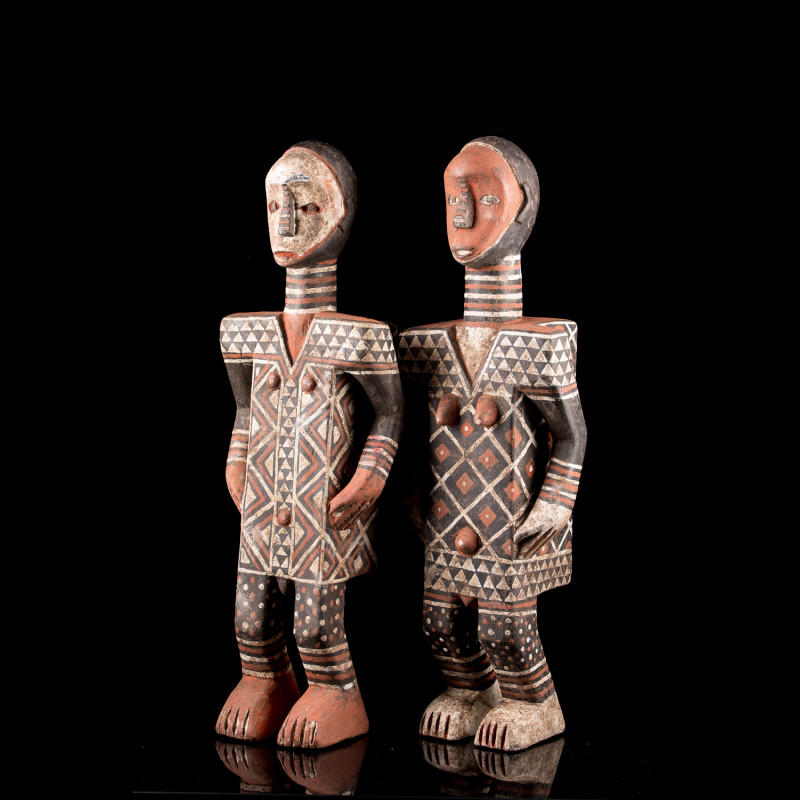















Deep in the sub-equatorial forests, rare, intriguing and exceptionally carved sculptures recapitulate in themselves, through traditional motifs and codes, the imagination of an entire people on the meaning of life and death.
Some of these sculptures are carved in such a way that a box opens in the back to hold human bones, and were used in funeral dances. The comparison deserves to be emphasised and undoubtedly calls for a comparative study. Similar figures, smaller than the sarcophagus, exist among the Nkundu/Ngata and call for further study.
Other peoples, such as the Fang, Tsogo and Kota, sculpted reliquary guardians, sometimes in wood, sometimes in metal, copper, brass and iron. In the middle and lower Congo, the Teke favoured ancestral worship while the Congo favoured royalty and divinatory rites. The Bwendé and the Bembé fashioned effigy-reliquaries from cloth. Among the former, after having been subjected to a process of desiccation by fumigation, the corpse is covered with mats, plant fibres and cloth and then placed in a giant reliquary, a sarcophagus in the true sense of the word, which can be up to three metres by four metres, carried in a procession and buried in a deep pit. These are the Niombo. Among the Bembe, the reliquary statues are made of cloth and their size, about 45 cm, contains a few relics; these are the Muzidi. At the same time, wooden sculptures containing relics and wrapped in cloth tied with fibres and cords are honoured.
The customs differ from one human group to another. The simplest formula remains the burial of the deceased in a mat or in a woven basket in which the deceased is wrapped with petioles of young palm trees. This practice is practised by the Nkundu and is known as bombai, carried out by the Bonsago association. Another practice was to place the deceased in a basket in a sitting position. The deceased may have worn a feathered headdress on his or her head, a reminder of social status.
In the region of Mbandaka, formerly Coquilhatville, there are several types of carved wooden sarcophagi. Some are anthropomorphic, others combine geometric and stylised zoomorphic elements on the assembly of two dugouts. The wood of anthropomorphic sarcophagi is often sprinkled with the blood of a sacrificial dog to ward off any evil from the grave.
Data sheet

Deep in the sub-equatorial forests, rare, intriguing and exceptionally carved sculptures recapitulate in themselves, through traditional motifs and codes, the imagination of an entire people on the meaning of life and death.
Some of these sculptures are carved in such a way that a box opens in the back to hold human bones, and were used in funeral dances. The comparison deserves to be emphasised and undoubtedly calls for a comparative study. Similar figures, smaller than the sarcophagus, exist among the Nkundu/Ngata and call for further study.
Other peoples, such as the Fang, Tsogo and Kota, sculpted reliquary guardians, sometimes in wood, sometimes in metal, copper, brass and iron. In the middle and lower Congo, the Teke favoured ancestral worship while the Congo favoured royalty and divinatory rites. The Bwendé and the Bembé fashioned effigy-reliquaries from cloth. Among the former, after having been subjected to a process of desiccation by fumigation, the corpse is covered with mats, plant fibres and cloth and then placed in a giant reliquary, a sarcophagus in the true sense of the word, which can be up to three metres by four metres, carried in a procession and buried in a deep pit. These are the Niombo. Among the Bembe, the reliquary statues are made of cloth and their size, about 45 cm, contains a few relics; these are the Muzidi. At the same time, wooden sculptures containing relics and wrapped in cloth tied with fibres and cords are honoured.
The customs differ from one human group to another. The simplest formula remains the burial of the deceased in a mat or in a woven basket in which the deceased is wrapped with petioles of young palm trees. This practice is practised by the Nkundu and is known as bombai, carried out by the Bonsago association. Another practice was to place the deceased in a basket in a sitting position. The deceased may have worn a feathered headdress on his or her head, a reminder of social status.
In the region of Mbandaka, formerly Coquilhatville, there are several types of carved wooden sarcophagi. Some are anthropomorphic, others combine geometric and stylised zoomorphic elements on the assembly of two dugouts. The wood of anthropomorphic sarcophagi is often sprinkled with the blood of a sacrificial dog to ward off any evil from the grave.